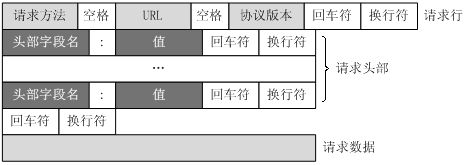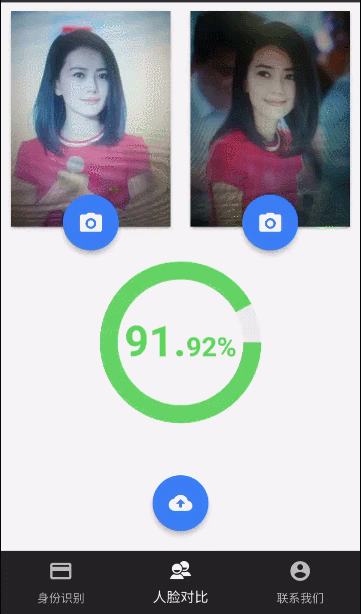我们先看看linkface给开放的接口:
| 字段 | 类型 | 必需 | 描述 |
|---|---|---|---|
| api_id | string | 是 | API 账户 |
| api_secret | string | 是 | API 密钥 |
| selfie_file | file | 见下方注释 | 需上传的图片文件 1,上传本地图片进行检测时选取此参数 |
| selfie_url | string | 见下方注释 | 图片 1 的网络地址,采用抓取网络图片方式时需选取此参数 |
| selfie_image_id | file | 见下方注释 | 图片 1 的id,在云端上传过图片可采用 |
| historical_selfie_file | file | 见下方注释 | 需上传的图片文件 2,上传本地图片进行检测时选取此参数 |
| historical_selfie_url | string | 见下方注释 | 图片 2 的网络地址,采用抓取网络图片方式时需选取此参数 |
| historical_selfie_image_id | string | 见下方注释 | 图片 2 的id,在云端上传过图片可采用 |
| selfie_auto_rotate | boolean | 否 | 值为 true 时,对图片 1 进行自动旋转。默认值为 false,不旋转 |
| historical_selfie_auto_rotate | boolean | 否 | 值为 true 时,对图片 2 进行自动旋转。默认值为 false,不旋转 |
如文件所示,接口需要同时上传两个文件和两个字段,一般我们的web前端就很简单了,两个file类型的input组成的form提交就可以,若想实现文件的异步上传通俗的方式就是安装浏览器安全插件,或者就是使用form表单的提交target指向为iframe,然后将iframe隐藏,使用视窗的父子级调用完成,但是这仍需要我们使用form组件选择文件,很显然这样会使得我们的移动APP体验极差,我们期望的就是使用相机拍完照然后直接异步上传执行检测,当然我们可以使用XMLHTTPReauest2拼接一个formatdata上传
//不完全代码
let formData = new FormData();
formData.append('fileName',input.files[0]);
xhr.open("post", encodeURI(url));
xhr.send(formData);但是,在web端,如果用户不使用input选择文件,我们是无法私自获取并上传文件的,这个浏览器的安全机制,想想如果可以拼接file://私自获取文件,我们还安全么?
那么针对于cordova plugin 就相当于我们浏览器的插件了,道理是一定的,通过js的方式调用底层接口。我们首先能够想得到的就是file-transfer这个插件,但是很遗憾的告诉你,这个插件一次只能上传一个文件, https://github.com/apache/cordova-plugin-file-transfer,
Parameters:
fileURL: Filesystem URL representing the file on the device or a data URI. For backwards compatibility, this can also be the full path of the file on the device. (See Backwards Compatibility Notes below)
server: URL of the server to receive the file, as encoded by encodeURI().
successCallback: A callback that is passed a FileUploadResult object. (Function)
errorCallback: A callback that executes if an error occurs retrieving the FileUploadResult. Invoked with a FileTransferError object. (Function)
options: Optional parameters (Object). Valid keys:
fileKey: The name of the form element. Defaults to file. (DOMString)
fileName: The file name to use when saving the file on the server. Defaults to image.jpg. (DOMString)
httpMethod: The HTTP method to use - either PUT or POST. Defaults to POST. (DOMString)
mimeType: The mime type of the data to upload. Defaults to image/jpeg. (DOMString)
params: A set of optional key/value pairs to pass in the HTTP request. (Object, key/value - DOMString)
chunkedMode: Whether to upload the data in chunked streaming mode. Defaults to true. (Boolean)
headers: A map of header name/header values. Use an array to specify more than one value. On iOS, FireOS, and Android, if a header named Content-Type is present, multipart form data will NOT be used. (Object)
trustAllHosts: Optional parameter, defaults to false. If set to true, it accepts all security certificates. This is useful since Android rejects self-signed security certificates. Not recommended for production use. Supported on Android and iOS. (boolean)我真搞不懂既然cordova plugin封装,为啥不封装成文件数组接口呢,支持多文件和困难么?那么我们就来看看他的源码:
boolean multipartFormUpload = (headers == null) || !headers.has("Content-Type");
if (multipartFormUpload) {
conn.setRequestProperty("Content-Type", "multipart/form-data; boundary=" + BOUNDARY);
}
// Set the cookies on the response
String cookie = getCookies(target);
if (cookie != null) {
conn.setRequestProperty("Cookie", cookie);
}
// Handle the other headers
if (headers != null) {
addHeadersToRequest(conn, headers);
}
/*
* Store the non-file portions of the multipart data as a string, so that we can add it
* to the contentSize, since it is part of the body of the HTTP request.
*/
StringBuilder beforeData = new StringBuilder();
try {
for (Iterator<?> iter = params.keys(); iter.hasNext();) {
Object key = iter.next();
if(!String.valueOf(key).equals("headers"))
{
beforeData.append(LINE_START).append(BOUNDARY).append(LINE_END);
beforeData.append("Content-Disposition: form-data; name=\"").append(key.toString()).append('"');
beforeData.append(LINE_END).append(LINE_END);
beforeData.append(params.getString(key.toString()));
beforeData.append(LINE_END);
}
}
} catch (JSONException e) {
Log.e(LOG_TAG, e.getMessage(), e);
}
beforeData.append(LINE_START).append(BOUNDARY).append(LINE_END);
beforeData.append("Content-Disposition: form-data; name=\"").append(fileKey).append("\";");
beforeData.append(" filename=\"").append(fileName).append('"').append(LINE_END);
beforeData.append("Content-Type: ").append(mimeType).append(LINE_END).append(LINE_END);
byte[] beforeDataBytes = beforeData.toString().getBytes("UTF-8");
byte[] tailParamsBytes = (LINE_END + LINE_START + BOUNDARY + LINE_START + LINE_END).getBytes("UTF-8");看到了吗,它是拼接了报文,这就是能够解释它为啥还需要依赖 cordova-plugin-file这个插件了,它可以直接获取文件ArrayBuffer,很聪明啊,真的很聪明,为什么拼报文?岂不是很麻烦,正常我么使用java的http client是需要依赖 httpclient-4.0.1.jar commons-codec-1.3.jar apache-mime4j-0.6.jar httpcore-4.0.1.jar httpmime-4.0.1.jar ,这无形之中就增大了app的大小,作为卡插拔式的插件,大小也是一个硬伤,所以封装插件的同学们学习吧,人家可不是盖的,拼接报文自然使得插件不需要依赖那些包了。
我们开脑补一下http报文协议:
一个HTTP请求报文由请求行(request line)、请求头部(header)、空行和请求数据4个部分组成,下图给出了请求报文的一般格式。

所以按照标准拼写报文也是可以的。
但是我是一个H5工程师,我首先会使用H5技术去解决这件事,不然我就只能发挥java技能更改file-transfer这个插件了。XHR拼接formdata,可以是file也可以是一个blob,我曾将想过是不是有接口能够模拟封装input的file或者使用FileReader,然而还是那句话,浏览器为了安全不会让我们自己拼接file:// 的,但是cordova跨平台可以访问文件系统(你可以看一下 https://github.com/apache/cordova-plugin-file里http-equiv="Content-Security-Policy"相关的描述),毕竟我们开发的是移动app,这个功能是不可缺少的,我们使用cordova的file plugin还是可以获取文件的我们来看看ionic2提供的接口(http://ionicframework.com/docs/v2/native/file/ ):
readAsArrayBuffer(path, file)
Read file and return data as an ArrayBuffer.
| Param | Type | Details |
|---|---|---|
| path | string |
Base FileSystem. Please refer to the iOS and Android filesystems above |
| file | string |
Name of file, relative to path. |
Returns: Promise<ArrayBuffer|FileError> Returns a Promise that resolves with the contents of the file as ArrayBuffer or rejects with an error.
惊喜吧!有个这个我们就能够自己拼写blob类型的formdata了,话不多说我们直接上代码:
先写封装一个文件转换类,file-convert-util.ts:
import {File, FileError} from "ionic-native";
/***
* @author 赵俊明
*/
export class FileConvertUtil {
constructor() {
}
//讲文件转换为Blob
public static convertFileToBlob(fullFilePath: string): Promise<Blob|FileError> {
return new Promise((resolve, reject)=> {
FileConvertUtil.convertFileToArrayBuffer(fullFilePath).then((arrayBuffer)=> {
resolve(new Blob([arrayBuffer], {type: "image/" + FileConvertUtil.extractFileType(fullFilePath)}));
}).catch((reason)=> {
reject(reason);
});
});
}
//将文件装换为ArrayBuffer
public static convertFileToArrayBuffer(fullFilePath: string): Promise<ArrayBuffer | FileError> {
return File.readAsArrayBuffer(FileConvertUtil.extractFilePath(fullFilePath), FileConvertUtil.extractFileName(fullFilePath));
}
//截取文件路径
public static extractFilePath(fullFilePath: string): string {
return fullFilePath.substr(0, fullFilePath.lastIndexOf('/'));
}
//截取文件名称
public static extractFileName(fullFilePath: string): string {
return fullFilePath.substr(fullFilePath.lastIndexOf('/') + 1);
}
//截取文件类型
public static extractFileType(fullFilePath: string): string {
return fullFilePath.split(".")[1];
}
}基于XHR2的upload,xhr-multipart-upload.ts:
import {BrowserXhr} from "@angular/http";
import {FileConvertUtil} from "./file-convert-util";
import {FileError} from "ionic-native";
import {Injectable, Component} from "@angular/core";
/**
* @author zhaojunming
*/
export class XHRMultipartFileUpload {
private static browserXhr = new BrowserXhr();
constructor() {
}
public static upload(url: string, files: {name: string,path: string}[], params: any): Promise<any> {
const xhr = XHRMultipartFileUpload.browserXhr.build();
xhr.open("post", encodeURI(url));
let formData = new FormData();
return new Promise((resolve, reject)=> {
if (params) {
for (let _v in params) {
if (params.hasOwnProperty(_v)) {
formData.append(_v, params[_v]);
}
}
}
let blobPromiseList: Array<Promise<Blob|FileError>> = [];
files.forEach((file)=> {
blobPromiseList.push(FileConvertUtil.convertFileToBlob(file.path));
});
Promise.all(blobPromiseList).then((result)=> {
result.forEach((blob, index)=> {
formData.append(files[index].name, blob, FileConvertUtil.extractFileName(files[index].path));
});
xhr.onreadystatechange = ()=> {
if (xhr.readyState == 4) {
if (xhr.status == 200) {
resolve(JSON.parse(xhr.responseText));
} else {
reject({code: xhr.status, message: JSON.parse(xhr.responseText)});
}
}
}
xhr.send(formData);
}).catch((reason)=> {
reject(reason);
});
});
}
}调用linkface的provider,linkface-verfication.ts:
/***
* @author 赵俊明
*/
import {Injectable, Component} from "@angular/core";
import {XHRMultipartFileUpload} from "./xhr-multipart-upload";
import {Storage, LocalStorage} from "ionic-angular";
//400 错误码对应信息
const ERROR_MAPPING = {
"ENCODING_ERROR": "参数非UTF-8编码",
"DOWNLOAD_TIMEOUT": "网络地址图片获取超时",
"DOWNLOAD_ERROR": "网络地址图片获取失败",
"IMAGE_FILE_SIZE_TOO_BIG": "图片体积过大 ",
"IMAGE_ID_NOT_EXIST": "图片不存在",
"NO_FACE_DETECTED": "图片未检测出人脸 ",
"CORRUPT_IMAGE": "文件不是图片文件或已经损坏",
"INVALID_IMAGE_FORMAT_OR_SIZE": "图片大小或格式不符合要求",
"INVALID_ARGUMENT": "请求参数错误",
"UNAUTHORIZED": "账号或密钥错误",
"KEY_EXPIRED": "账号过期",
"RATE_LIMIT_EXCEEDED": "调用频率超出限额",
"NO_PERMISSION": "无调用权限",
"NOT_FOUND": "请求路径错误",
"INTERNAL_ERROR": "服务器内部错误"
};
@Injectable()
export class LinkFaceVerfication {
//普通照片比对URL
private historicalSelfieVerificationURL = "https://v1-auth-api.visioncloudapi.com/identity/historical_selfie_verification";
//公安水印照片与普通照片比对URL
private selfieWatermarkVerificationURL = "https://v1-auth-api.visioncloudapi.com/identity/selfie_watermark_verification";
private apiId: string;
private apiSecret: string;
//LocalStorage
private storage = new Storage(LocalStorage);
constructor() {
this.getApiId()
.then(apiId=> {
this.apiId = apiId || "6b666502c4324026b8604c8001a2cd14";
})
.catch(()=> {
this.apiId = "6b666502c4324026b8604c8001a2cd14";
});
this.getApiSecret()
.then(apiSecret=> {
this.apiSecret = apiSecret || "28cf8b8693e54d0b930d0a5089831841";
})
.catch(()=> {
this.apiSecret = "28cf8b8693e54d0b930d0a5089831841";
});
}
//普通照片比对
public historicalSelfieVerification(selfie_file: string, historical_selfie_file: string, selfie_auto_rotate: boolean = true, historical_selfie_auto_rotate: boolean = true): Promise<any> {
let params = {
api_id: this.apiId,
api_secret: this.apiSecret,
selfie_auto_rotate: selfie_auto_rotate,
historical_selfie_auto_rotate: historical_selfie_auto_rotate
};
let files = []
files.push({name: "selfie_file", path: selfie_file});
files.push({name: "historical_selfie_file", path: historical_selfie_file});
return new Promise((resolve, reject)=> {
XHRMultipartFileUpload.upload(this.historicalSelfieVerificationURL, files, params)
.then(result=> {
resolve(result);
})
.catch(error=> {
if (error && error.code == 400) {
reject(ERROR_MAPPING[error.message.status]);
} else {
reject(JSON.stringify(error));
}
});
});
}
//公安水印照片与普通照片比对
public selfieWatermarkVerification(selfie_file: string, watermark_picture_file: string): Promise<any> {
let params = {api_id: this.apiId, api_secret: this.apiSecret};
let files = []
files.push({name: "selfie_file", path: selfie_file});
files.push({name: "watermark_picture_file", path: watermark_picture_file});
return new Promise((resolve, reject)=> {
XHRMultipartFileUpload.upload(this.selfieWatermarkVerificationURL, files, params)
.then(result=> {
resolve(result);
})
.catch(error=> {
if (error && error.code == 400) {
reject(ERROR_MAPPING[error.message.status]);
} else {
reject(JSON.stringify(error));
}
});
});
}
setApiId(apiId): boolean {
if (apiId) {
this.apiId = apiId;
this.storage.set("apiId", apiId);
return true;
}
return false;
}
setApiSecret(apiSecret): boolean {
if (apiSecret) {
this.apiSecret = apiSecret;
this.storage.set("apiSecret", apiSecret);
return true;
}
return false;
}
getApiId(): Promise<string> {
return this.storage.get("apiId");
}
getApiSecret(): Promise<string> {
return this.storage.get("apiSecret");
}
}
看看我们怎么调用:
this.linkFaceVerfication.historicalSelfieVerification(this.selfie_file, this.historical_selfie_file, true, true)
.then(result=> {
this.confidence = (result.confidence * 100).toFixed(2);
this.uploading = false;
})
.catch(reason=> {
this.toastMessage(reason);
this.uploading = false;
});我们来看看效果:

来源:oschina
链接:https://my.oschina.net/u/259422/blog/747399